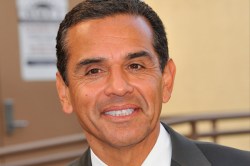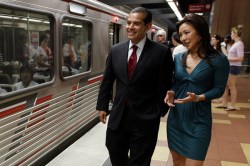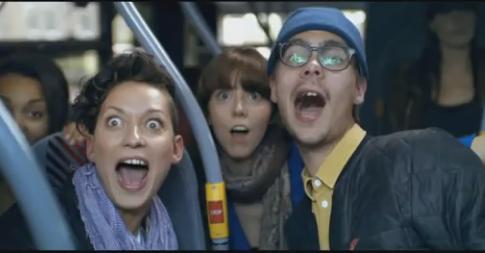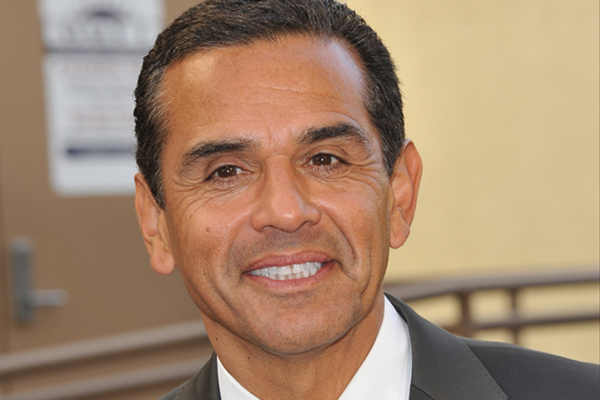
The mayor. (Photo by Shutterstock.)
You recently saw L.A. Mayor Antonio Villaraigosa grinning, hugging, back-patting, and fist-pumping between acts in his role as chair of the Democratic National Convention. Villaraigosa, who was a labor organizer and then speaker of the state Assembly before he became mayor in 2005, also wants recognition for another leadership role: He calls himself America’s greenest mayor, and he calls his city the cleantech capitol of the U.S.
We spoke to Villaraigosa about the impact of the convention, his efforts to make his city-state a model of climate progress, and his progress in dragging Angelenos out of their cars.
Q. Hello, Mayor Villaraigosa.
A. I can’t believe you said my name right!
Q. I’ve been practicing.
A. I can tell. Most people screw it up.
Q. Tell me how you think the convention went.
A. I think the overwhelming opinion of the delegates was that this was the smoothest, best, most exhilarating convention they’ve ever gone to. It was the hundreds of staff members and thousands of volunteers, the hospitality of Charlotte, the consistent themes throughout, the soaring rhetoric—and it wasn’t just the soaring rhetoric, there were facts.
Q. How much of a bounce do you think Democrats and the president are getting from it, and will that last?
A. Last I saw, we got a 4-point bump in the polls. We went from I think 11 or 12 points down among white men and we’re now virtually even, or leading by 1. It’s hard to say if it will last — we’re up by 4 in a very close election that’s gonna go all the way down to the wire.
Q. Up until the president spoke, almost nobody mentioned climate change. Why do you think the issue has fallen off the federal Democratic agenda?
A. It certainly hasn’t fallen off Democratic mayoral agendas. It’s not just L.A. — it’s New York, Chicago, San Francisco, Seattle, Portland, Austin. Mayors across the country—we’re all focused on our carbon footprint
But I would agree that at this convention the issue wasn’t touched as often as it was four years ago. Maybe it’s because there’s such a focus on the economy, and also because there was a great deal of focus on the assault on women, issues relating to choice and contraception, and the focus on the dreamers and immigration.
Q. Do you think that climate progress on a national level is impossible right now? Is it up to states and cities to push this issue forward?
A. At the national level you need two parties to do something serious around climate change and our energy policy. We don’t have that kind of bipartisan effort, so now cities, particularly global cities, city-states like mine, are leading the way.
The one thing the national government and the mayors share in common is that everybody’s elbowing each other. The national leaders were elbowing each other to see who could do the least and who is most to blame on climate change. The mayors are elbowing each other to see who can do the most on climate change.
Q. How are you reducing L.A.’s climate impact?

Villaraigosa proudly admires L.A.’s public transit system. (Photo by David Starkopf / Office of the Mayor.)
A. I got elected in July 2005 and immediately signed on to Kyoto targets of reducing greenhouse gases 7 percent below 1990 levels by 2012. We achieved that by 2009. Now in 2012, we’re close to 15 percent reduction in greenhouse gases. We’ve gone from 3 percent renewables to 20 percent renewables. We’ve opened up four light-rail lines and a bus way; every single bus is alternative fuel. We’re electrifying our port, so instead of spewing dirty diesel, trucks have to plug in. We’ve had upwards of an 80 percent reduction in diesel emissions. We’ve planted nearly 400,000 trees. We’ve installed nearly 100,000 LED street lamps, and nearly 4,000 LED traffic lights, plus we’re starting a process of putting up solar panels as we do the LEDs so our lights will go off the grid. We’ve got one of the toughest green building standards in the country. All told, we’re conserving 19 times the energy that we used to.
Q. You’ve also developed an Adapt LA framework to begin preparing your city for the impacts of climate change. Part of this effort was a study on “Mid-Century Warming in the Los Angeles Region” to predict the most severe impacts of warming on your neighborhoods. What were the most alarming findings?
A. Let me just say why I did Adapt LA. We’ve had a 34 percent reduction in water use [since I took office]. We got there with a requirement that was very, very unpopular: I went to two days of [lawn watering allowed per week]; people’s lawns went brown. I was vilified by the public, and I stood my ground and said we can’t keep on using water like we live in Seattle.
So I launched the study to see if the science would verify that L.A. and the whole region is getting hotter [and droughts more severe]. It found that we’re gonna double the number of “extremely hot days” over 90 degrees in downtown. In the San Fernando Valley, we’re gonna triple the number of extremely hot days. In the San Bernardino/Riverside area, we’re gonna quadruple the number of extremely hot days.
The other alarming prediction was the sea-level rise — we have to prepare for the impact on the port, where we move 44 percent of all seaborne goods, and on waterfront neighborhoods like Venice and Santa Monica.
Q. You’re adding more than 170 acres of new parks with the “50 Parks Initiative,” in addition to the 660 acres of parks you’ve already installed. Why have you pushed so hard to add this green space?
A. If you fly over L.A., you’ll see the pockets of park space and tree canopy, and they’re almost exclusively in the more affluent neighborhoods. Our parks initiative focuses on areas that are people-rich and park-poor. So they’re disproportionately in south L.A., downtown, and the east side, the areas of the city that don’t have as much tree canopy. In these communities, parks provide beauty, tree canopy, and shade; they build morale in the community; they invite more pedestrian traffic and exercise; and they lower crime rates.
On all the parks, we have decorative fencing with automatic time-lock gates; we have solar waste bins that reduce waste-collection frequency by 80 percent; we have motion-activated cameras there that are solar-charged and digital; we have efficient landscaping and irrigation, so it’s very cost-effective.
Q. You’ve been working to expand mass transit in L.A. and institute a bike-sharing program. Is it hard to get Angelenos out of their cars?
A. Angelenos are more excited than anyone to get out of their cars—they’re so ready! We passed a half-penny sales tax, generating $40 billion to double the size of our rail system. It was supposed to happen over 30 years, but I think we can get it done it 10.
Our bike-sharing system is already up and running in parts of the city, and in 2011 we did a CicLAvia bike and pedestrian tour of the city that 200,000 Angelenos took part in — it was incredible. And another CicLAvia event is coming up Oct. 7.

Villaraigosa talks up biking at a recent CicLAvia. (Photo by David Starkopf / Office of the Mayor.)
Q. It was great to hear Julian Castro at the convention; he’s been making big strides toward building a green economy in San Antonio. You and he are upending the criticism that the environmental movement and its leaders are too white. Do you think we’ll be seeing a new generation of politicians of color who are leading the movement toward climate action and cleantech?
A. Everybody needs to buy in. As mayor, I’ve had a 100 percent record with the [California League of Conservation Voters], certainly the greenest mayor of any color. I’ve been working on a green agenda since 1994 when I was [elected to the state Assembly]. What I’ve told the enviros from the beginning was that we need to connect the environment to social justice, we need to successfully challenge the argument that environmental progress undercuts jobs. When we’re talking about the benefits of environmental and sustainable practices, we’ve got to connect that to jobs and job creation, and importantly, we can’t focus just on the affluent area and the suburbs.
We’ve made L.A. the cleantech capitol of the U.S. with a corridor downtown, to attract cleantech companies. So we’ve worked hard to translate our sustainability efforts into real, measurable job-creation numbers. That’s what will ensure that everybody buys in to environmental progress.



